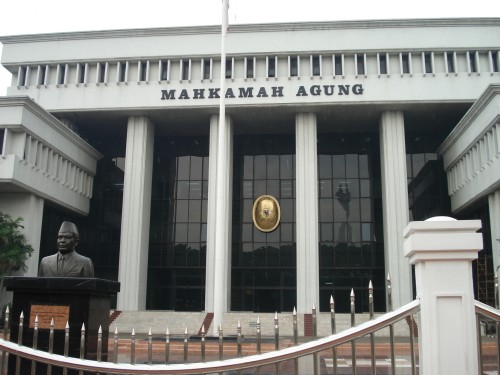
The New Indonesian Constitutional Court
April 2007
A study into its beginnings and first years of work
by Petra Stockmann
[…] Constitutional courts in transition countries face a number of additional challenges: For one, the courts will in one way or another have to deal with the legacy of the past authoritarian regimes. Questions of transitional justice may also touch upon the realm of constitutional jurisdiction and might collide with the principle of upholding the law. And then there is the question of what law the court has to uphold. Is the constitution a document that enshrines unambiguously the principles of a democratic constitutional state under the rule of law and human rights protection? Or was an authoritarian constitution amended in a patchwork fashion, the process dominated by short term (self-)interests and political compromises of the day? If more of the latter is the case, then the constitution in question might be fraught with inconsistencies and provisions which justice-minded judges might find difficult to uphold. What raises the question of how creative judges may be in their interpretation of the constitution, which is, once more, a question of boundaries.
What boundaries then have the authors of the Indonesian Constitution and the Indonesian legislators set up for the country’s new constitutional court? How do the judges deal with their tasks, their authority, and the challenges their jobs pose? And how broad is the access to the court? Can – and do – people make use of this new judicial recourse? The following study tries to find answers to these and other questions whereby the guiding one will be: Has the Indonesian Constitutional Court contributed to further democratisation, rule of law and human rights protection? In Chapter II of the study, the reader will be led back to the beginnings of the Indonesian Constitutional Court, the Mahkamah Konstitusi: how in a last minute compromise the Law on the Constitutional Court was enacted, and how the selection process to determine the judges was rushed through so that the court could be established on August 17th, 2003, as the constitution demanded. The judges had to start from scratch, as we shall see. They had no court room, no offices, no staff – only, as one of them recalled, three documents: the constitution; the Law on the Constitutional Court determining the details on their tasks; and the presidential decree documenting that they were Indonesia’s first guardians of the constitution.
In Chapter III, the mentioned documents shall concern us in a bit more detail. From the brief overview of the constitution the reader will get an idea about the nature of the document that serves as the basis for the judges’ work. Are key democratic rechtsstaat principles enshrined therein? As concerns the Law on the Constitutional Court, we shall see what boundaries legislators determined for the judges, the focal question being: Who guards the guardians of the constitution? Last, but not least, the reader can accompany, Ibu Ina, a fictitious person, in her quest for justice, i.e. follow her around as she pursues her judicial review petition, and thus learn about the Constitutional Court’s procedures.
In Chapter IV, the reader can familiarise him- or herself with the court’s work. The focus will be on selected judicial review cases that the court has ruled on in its first two and a half years. For each case, the socio-political background is sketched and the verdict outlined. The argument in the rulings is often emphatic, and positions are vehemently defended. In their dissenting opinions, the judges are outspoken and do not mince their words. To get an idea about the controversial positions on contested issues, I have juxtaposed the judges’ different opinions. From selected reactions by petitioners, government and parliament representatives, and NGOs, one can get an impression of how the rulings have been received.
The verdicts presented in the study cover a wide range of issues. I have chosen rulings, which have in one way or another broader implication and touch upon fundamental questions. They are: May legislators put a time limit on the Constitutional Court’s jurisdiction? Is it constitutional that former members of the Indonesian Communist Party are deprived of their passive voting right? How about the special autonomy for the Province of Papua and the partition process? May laws be applied retroactively to try crimes committed in East Timor 1999 and to the Bali bombings? Where has the court drawn the line concerning state control over key sectors of the economy? And finally, is the government obliged to immediately allocate 20 percent of the budget to education as the constitution demands?
After two and a half years in office, it’s half-time for the judges. Time to stand back and take stock provisionally. Which is attempted, in a modest way, in the concluding chapter of the study.
Read the full report here. (PDF, 600 kB)








